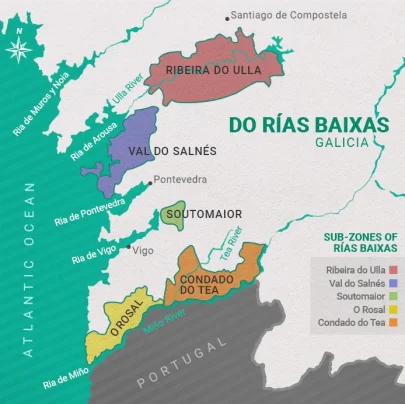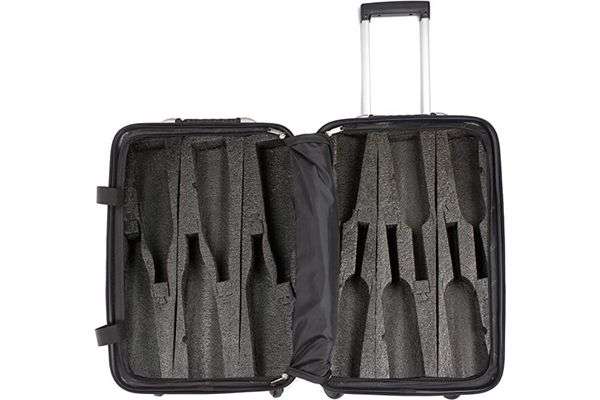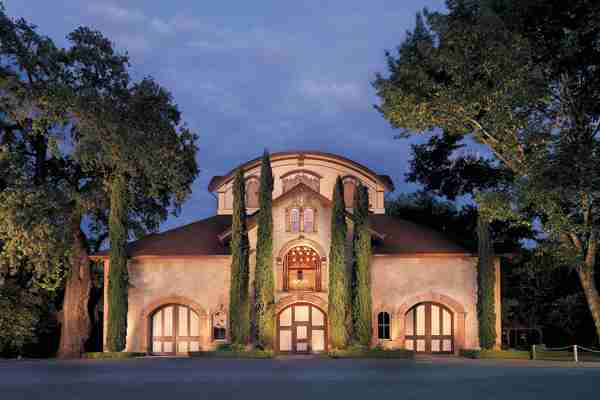Rías Baixas: 10 Things we love about you
Rías Baixas is pronounced REE-ahs BI-shas.
Traveling to the Rías Baixas wine region? We’re sharing the top 10 things you need to know and love. From where to stay and things to do (boy do we have some whoppers), to tasting notes, food pairing and buyer’s guide.
Get acquainted with the Rías Baixas wine region.
Hold on to your butts!
Every bottle of wine is an opportunity to learn something.
This is why I enjoy participating in wine chats on the interweb. Most often, they’re live discussions on wine travel, education and tasting.
We discuss things like terroir winemaking, grape varieties, culture and pairings.
The theme for this month’s chat is Albariño from Rías Baixas. And I was so excited to share our tips on how to travel to the region.
Wine first. Then, travel.
If you’re here for the Rías Baixas wine travel tips, scroll to the travel map at the bottom.

10 Things To Know About Rías Baixas
Here are 10 things to know about Rías Baixas.
Rías Baixas Geography
Rías Baixas is located in northwestern Spain, in a region called Galicia (aka Green Spain), which looks more like coastal Ireland than the typical mental picture of Spain, which is hot, dry and dusty.
The Terroir Of Rías Baixas
Granite and schist soils mix with the influences of the Atlantic to create the high natural acidity, citrus flavors, and sea spray minerality.
Rías Baixas Translation
Rías Baixas translates to Low Rivers. It’s pronounced Rías Baishas.
The Climate In Rías Baixas
The climate in Rías Baixas is coastal, averaging 1800 mm (that’s just over 70 inches) of rainfall per year. By comparison, the rainiest city in the United States (Mobile, Alabama) gets 67 inches of rain per year; Seattle checks in at a paltry 38 inches.
Rías Baixas DO Designation
In 1980, a specific Denominación de Origen, or DO, was created specifically for the Albariño grape.
However, when Spain entered the European Union in 1986, the name of the DO was changed to Rías Baixas because EU laws don’t recognize DO’s named for a single grape variety.
Wine Produced In Rías Baixas
Over 99% of the wine produced in Rías Baixas is white, and of that total, 90% is Albariño (a fantastic grape that makes a crisp refreshing wine thats great for summer.
Albariño’s Creation
Although its genesis is uncertain, prevailing thought says Albariño is a Riesling clone, brought to the area by German monks in the 12th (ish) century. Another theory is that Albariño is related to Petit Manseng.
Albariño’s Profile
Albariño is characterized by high acidity, intense aromatics, and low alcohol.
Sometimes, there’s a slight saline quality to the wines.
Most Albariño is unoaked, but there are examples of oak-aged Albariños available.
Grape Varieties Of Rías Baixas
There are 12 grape varieties permitted in Rías Baixas.
- Albariño
- Treixadura (traditionally blended with Albariño)
- Loureiro
- Caiño
- Torrontes
- Godello
- Castañal
- Espadeiro
- Sousón
- Mencía
- Brancellao
- Dozal
Crossing The Minho River From Rías Baixas
Across the Minho (or Miño) River from Rías Baixas into Portugal, Albariño is made as Vinho Verde (technically, Vinho Verde is both a wine and a region).
Vinho Verde translates literally to green wine (aka young wine).
Portuguese Alvarinho has lighter body, lower alcohol, and a slight effervescence. It’s meant to be consumed very young.
Sub Regions Of Rías Baixas
From north to south, the DO Rías Baixas encompasses five distinct sub-regions.
These subregions all share a unique, coastal climate, but the soils are slightly different, allowing for a wide range of Albariño styles.
The coastal soils in Rías Baixas are principally granitic, acidic and shallow.
They are frequently located less than 300 meters away from the sea.
The intense rainfall causes the soils to crumble, breaking the granite particles and turning them into sand, a phenomenon that is referred to locally as xiabre.

Where To stay and what to do in the Rías Baixas wine region
Map of the rías baixas wine region
Depending on your travel intentions and expectations, you could either stay in Santiago de Compostela and make a day trip into the Rías Baixas wine region or you can rent a car and travel from sub region to sub region, sipping, eating tapas and staying in little towns along the way.
Most choose to stay in Santiago de Compostela and make a day trip to Val Do Salnés or Ribeira Do Ulla. It’s only a 1 hr drive from Santiago de Compostela to Isla de la Toja. And you absolutely must make a trip to Isla de la Toja.
If you have an overnight stay planned in Isla de la Toja, Hotel Talaso Louxo La Toja is our top pick with it’s very affordable rates, good wi-fi, free parking near by, great restaurant (the breakfast is very good!), and room service is available for when you get home from an excursion and just want to crash out.
And if you’re looking for another activity from Isla de la Toja, please take a cooking class! We love taking cooking classes wherever we travel to. It’s one of the best ways to really experience the culture. And who doesn’t love to eat, come on? In Rocio’s cooking class you will learn Grandma’s recipes!
Ribeira do Ulla
The newest Rías Baixas sub-region (registered in 2000). Soils here are mostly alluvial.
Val do Salnés
Val do Salnés is known as the birthplace of the Albariño grape.
Val do Salnés is the original and oldest sub-region, and has the most acres under vine.
It’s also the coolest and wettest sub-region, and known for a crisp, aromatic style of wine. Soils here are alluvial over granite.
As this is the most famous sub-region of the Rías Baixas DO, there are numerous wineries to visit here. This full day trip into Val Do Salnés will arrange to meet you Santiago de Compostela or in one of the towns they plan to stop in along the way, if you happen to be staying in this region.
Soutomaior
The smallest of the sub-regions (registered in 1996). The soils here are alluvial over granite.
If you have an overnight stay planned in Vigo, Hotel Bahía de Vigo will give you the most bang for your buck!
The hotel is between Vigo’s old town and Cies Islands’ departure pier. It has views of the Vigo Estuary and pretty decent wi-fi (which is awesome if you’re working remotely).
You can travel into the Soutomaior to the north, Condado do Tea to the east and O Rosal to the south (bordering Portugal).
If you just want to show up and have someone else take the planning off you, this tour will take you into the Rías Baixas region with pre-planned stops (including a lunch spot-although lunch is at your own expense).
Condado do Tea
The furthest inland sub-region, named after the Tea River, a tributary of the Miño. The climate here is warm and dry. It’s known for earthier styles of wines — more powerful, but with less acidity.
Soils here are granite and slate, and appear on the surface with lighter granite subsoil.
O Rosal
Lying along the Miño River, this sub-region forms the border with Portugal.
It’s known for a soft, stone-fruit style of wine.
Many O Rosal producers blend Albariño with other allowed grape varieties, such as Treixadura and Loureiro.
Soils here are alluvial over granite.
Want to bring your rías baixas wine home with you?
We recommend the VinGardeValise 12 bottle wine suitcase. There are a couple ways you can use this suitcase. One is, when you come home you only pack half the suitcase with wine and the other side clothes; or, what we do is bring a duffle bag to carry our clothes home. You can still check a duffle bag home btw, you don’t have to schlep it around for all four connections.
Pro tip: you can also use the duffle bag to drop off your clothes to be laundered if you’re doing an extended trip. Multiple uses for one duffle bag.
The Camino de Santiago
I would be remiss to not mention The Camino de Santiago (even thought it is NOT in the Rías Baixas wine region).
The Camino de Santiago (translates to the “Way of St. James”) is famous. It is Europe’s ultimate pilgrimage route.
Since the Middle Ages, pilgrims have walked hundreds of miles across North Spain to pay homage to the remains of St. James in the city, Santiago de Compostela.
Traditionally, Santiago-bound pilgrims would gather in the the French Basque town of St-Jean-Pied-de-Port. Then cross the Pyrenees and continue their march through Spain.
This route takes just over a month to complete.
Or, you can begin in the popular beginning town of Sarria. There are many tours that will transfer you from Compostela de Santiago to Sarria. G Adventures will do this. This route takes 8 days to walk. There are rustic villages and lovely Inns along the way. However this option is very expensive. If you want to travel this route on your own, just arrange a transfer and follow the path.
A lesser known company will cut your costs by half and still cover logistics, overnight stays and breakfast and dinner.
Rías Baixas Buyer’s Guide
Order today and have it in time for your weekend dinner party you’re no doubt hosting.
- Lagar de Cervera Pazo de Seoane 2020
- Blanquito Albarino 2021 /91 points
- Pair with bay shrimp salad.
- Bodegas Fillaboa Albarino Rias Baixas 2021 /92 points
- Aromas and flavors of chalkiness, ripe apples, and savory spices. Pair with a fish stew.
- Bodegas Rectoral do Umia Calazul Albarino 2021 /91 points
- Forjas del Salnes Leirana Albarino 2021 /94 points
- The salinity of Leirana makes it a natural pair for scallops, oysters and shellfish of all kinds.
- Do Ferreiro Albarino 2021 /94 points
- Terras Gauda Abadia de San Campio Albarino 2021 /91 points
- La Cana Albarino 2021
- Pazo de Barrantes Albarino 2019 /94 points
- #57 Wine Spectator Top 100 of 2021
This new Pazo de Barrantes will surprise with an extremely elegant and expressive nose; fine aromas of white stone fruits, hints of citric fruits, balsamic nuances, acacia blossoms and bay. Liveliness and freshness in the palate, with a fluid texture and a balanced, long finish.
- Pairs beautifully with grilled queen scallops over truffled potatoes and cavia, mille-feuille filled with smoked eel, white asparagus pudding, white shrimp with mint, marinated sardine, grapefuit jam and blood orange.
- The suggested serving temperature is 52ºF.
- #57 Wine Spectator Top 100 of 2021
Rías Baixas Food Pairing
When thinking about pairing food with Albarińo, you cannot go wrong with seafood.
Scallops, oysters and shellfish of all kinds. Including Paella.
Looking for a pairing with your artichokes? YES, Albariño.
Rías Baixas FAQ
What kind of wine is Rías Baixas?
The Spanish wine region of Rías Baixas makes some of the world’s most elegant white wines and is home to the native grape variety, Albariño. Although over 90% of wine from Rías Baixas is Albariño, there are 12 grape varieties permitted in Rías Baixas.
What does Rías Baixas mean in Spanish?
Rías Baixas translates to Low Rivers. It’s pronounced Rías Baishas. The landscape is a rocky coastline with green hills and forests. Can you imagine anything more beautiful?
What does Rías Baixas mean in English?
Rías Baixas translates to Low Rivers. It’s pronounced Rías Baishas. The landscape is a rocky coastline with green hills and forests. Can you imagine anything more beautiful?
What are the soils of Rías Baixas?
The soils of Rías Baixas are a mix of granite and schist with influences of the Atlantic Ocean which creates the high acidity, citrus flavors, and sea spray minerality. Yum.
Is Rías Baixas wine dry?
The Spanish region of Rías Baixas has high acidity, citrus flavors, and sea spray minerality. It is usually described as clean, fresh and dry and tastes of green apple. Pair this with shellfish, white fish or fresh salads.










